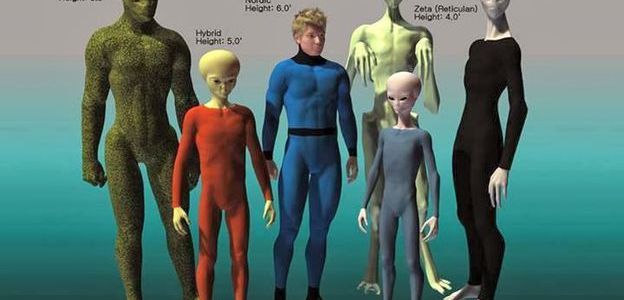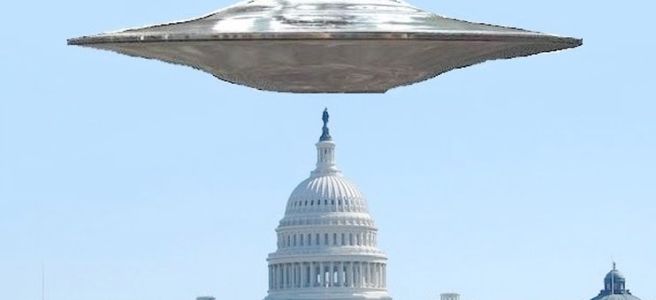I had the pleasure to explore with M J Banias the relation between the UFO mythos and various racist and extremist ideologies. The thoughts that follow I owe to Banias’ welcome invitation to discuss the matter and to our subsequent lively conversation, which, happily, posed more questions than it answered!
ε
That UFOs might impinge in any way on “the real word” is a bizarre thought. That flying saucers and their extraterrestrial pilots have been ubiquitous in the popular imagination for a lifetime now will meet with ready acceptance, but that such a flighty fantasy might bear in any way on the grave matters of real life is a proposal not to be taken seriously. At least until one learns that the leader of a Brazilian UFO contactee group carried out false-flag terrorist attacks with members of Brazil’s security forces between December 1967 to August 1968 to prop up the nation’s dictatorial regime, or that Oklahoma City bomber Timothy McVeigh, a fan of Bill Cooper’s radio show, had visited Area 51 and while on death row watched Contact six times in two days.
On the face of it, it shouldn’t be surprising that members of the UFO community, being ordinary people, too, will have their opinions concerning politics and society, from the banal to the extreme. That Jacques Vallée has little patience for the French Left or that Richard Dolan believes that the marriage of free market capitalism and liberal democracy is the best of all possible worlds have likely little or nothing to do with their ufological concerns. Likewise, racist ideas shared by a member of MUFON or racist and anti-Semitic slurs from the mouth of a channeler are probably inspired by the racist and anti-Semitic ideas of these respective people not their ufological or New Age interests and beliefs.
But the relation can be more complicated. James Gilliland’s pronouncements from the ECETI ranch, despite their claiming to take up “an objective non-party non-political approach” are vehemently anti-“Left”, critical of identity politics, pro-Trump, and conspiracist. That his newsletters evoke both the “lame stream media” (modern American English for that bit of Nazi propaganda, die Lügenpresse (“lying press”)) and New Age “Universal” or “Natural Law” suggests a less than accidental relation between his politics and ufological beliefs.
Right wing politics and ufology are even more intimately related for Michael Salla, who finds support for his exopolitical beliefs in the Q Anon conspiracy theory. He gathers that some of the crumbs dropped by Q confirm his  beliefs about human-extraterrestrial interaction and a Secret Space Program. However, in the same mouthful, he also swallows the line that Trump was recruited and placed in power by a group of “White Hats” working to unmask and destroy the “Deep State” (“aka Cabal / Illuminati / Global Elite“). Here, he takes up whole cloth an old elaborate conspiracy theory first elaborated by fellow Australian Stan Deyos in his 1973 The Cosmic Conspiracy, which weaves strands of the UFO myth together with older threads about the Illuminati, which, in turn, Salla twists together with fantasies about Satanic pedophile rings and even more sinister, anti-Semitic ones, in this case, attacks on the Rothschilds and George Soros.
beliefs about human-extraterrestrial interaction and a Secret Space Program. However, in the same mouthful, he also swallows the line that Trump was recruited and placed in power by a group of “White Hats” working to unmask and destroy the “Deep State” (“aka Cabal / Illuminati / Global Elite“). Here, he takes up whole cloth an old elaborate conspiracy theory first elaborated by fellow Australian Stan Deyos in his 1973 The Cosmic Conspiracy, which weaves strands of the UFO myth together with older threads about the Illuminati, which, in turn, Salla twists together with fantasies about Satanic pedophile rings and even more sinister, anti-Semitic ones, in this case, attacks on the Rothschilds and George Soros.
This tendency of certain aspects of the UFO mythology to combine with extreme right wing ideologies was noted with some anxiety by Jacques Vallée in his 1991 book Revelations.
Another aspect many researchers of this field—with a few courageous and notable exceptions—have studiously ignored, is the link between the more eager proponents of imminent extraterrestrial contact and the American extreme right….
It could well be that the same kind of fanaticism that leads people to join neo-Nazi, anti-Semitic, and survivalist movements in the American southwest also induces them to believe in the imminent arrival of aliens from the sky. It could be that these groups who are convinced that government secrecy is abused in order to hide political truths from the public also believe that the reality of UFOs has been kept from us… (256-7)
That nexus of stories about “imminent extraterrestrial contact and the American  extreme right” had been growing in the decade leading up to Vallée’s expression of concern and was about to effloresce in the years following. Ufologically, an important set of rumours was begun, first thanks to Stanton Friedman’s groundbreaking research into the crash at Roswell in 1978, which was quickly followed by Berlitz’s and Moore’s 1980 The Roswell Incident. By 1984, the MJ-12 documents had surfaced, and, by 1988, an entire submythology had developed, about crashed flying saucers, retrieved and back-engineered alien technology, recovered ufonauts living and dead, treaties with alien races that traded technological know-how for the rights to mutilate cattle and abduct human beings, underground bases both human and alien, and the struggle to reveal this “horrible truth” that culminated in the TV documentary “Cover-Up: Live!” and the most ambitious synthesis of these tales with New World Order conspiracy theories, Bill Cooper’s Behold a Pale Horse (1991). Following the incidents at Ruby Ridge (1992) and Waco (1993), those “neo-Nazi, anti-Semitic, and survivalist movements in the American southwest” and the conspiracy theories that went with them would in turn explode in number, only to slowly decrease until the elections of Barack Obama and Donald Trump breathed new life into their paranoia and sense of legitimacy.
extreme right” had been growing in the decade leading up to Vallée’s expression of concern and was about to effloresce in the years following. Ufologically, an important set of rumours was begun, first thanks to Stanton Friedman’s groundbreaking research into the crash at Roswell in 1978, which was quickly followed by Berlitz’s and Moore’s 1980 The Roswell Incident. By 1984, the MJ-12 documents had surfaced, and, by 1988, an entire submythology had developed, about crashed flying saucers, retrieved and back-engineered alien technology, recovered ufonauts living and dead, treaties with alien races that traded technological know-how for the rights to mutilate cattle and abduct human beings, underground bases both human and alien, and the struggle to reveal this “horrible truth” that culminated in the TV documentary “Cover-Up: Live!” and the most ambitious synthesis of these tales with New World Order conspiracy theories, Bill Cooper’s Behold a Pale Horse (1991). Following the incidents at Ruby Ridge (1992) and Waco (1993), those “neo-Nazi, anti-Semitic, and survivalist movements in the American southwest” and the conspiracy theories that went with them would in turn explode in number, only to slowly decrease until the elections of Barack Obama and Donald Trump breathed new life into their paranoia and sense of legitimacy.
The belief that “that the reality of UFOs has been kept from us” has a long ufological pedigree. Donald Keyhoe already in his first book The Flying Saucers are Real (1950)  posits that the USAF knows UFOs are extraterrestrial spaceships but suppresses this acknowledgement and actively debunks sightings in the name of national security; the truth will be revealed only after a careful process of acclimatization via strategic leaks, disinformation, and the entertainment media, all leading up to a moment of “disclosure”. It’s not until the process of decay of public trust in the US government sets in, with the growth of the American national security state, beginning with the founding of the CIA in 1947, and with “deep events”, such as the Kennedy assassination, Watergate, Iran-Contra, and, most recently, 9/11, (which in turn lead to notions of an “invisible government” as early as 1964, the “shadow government”, and the “deep state”) that The Flying Saucer Conspiracy (the title of Keyhoe’s 1955 book) devolves into the “horrible truth” expounded by the likes of Bill Cooper and John Lear that finds affinities with the New World Order conspiracy theories of the American militia movement.
posits that the USAF knows UFOs are extraterrestrial spaceships but suppresses this acknowledgement and actively debunks sightings in the name of national security; the truth will be revealed only after a careful process of acclimatization via strategic leaks, disinformation, and the entertainment media, all leading up to a moment of “disclosure”. It’s not until the process of decay of public trust in the US government sets in, with the growth of the American national security state, beginning with the founding of the CIA in 1947, and with “deep events”, such as the Kennedy assassination, Watergate, Iran-Contra, and, most recently, 9/11, (which in turn lead to notions of an “invisible government” as early as 1964, the “shadow government”, and the “deep state”) that The Flying Saucer Conspiracy (the title of Keyhoe’s 1955 book) devolves into the “horrible truth” expounded by the likes of Bill Cooper and John Lear that finds affinities with the New World Order conspiracy theories of the American militia movement.
This parallel development of narratives around UFO secrecy and the conspiracy theories held by various American anti-government groups arguably shows that UFO conspiracy theories are not essentially racist and that those of anti-government groups don’t necessarily entail an interest in UFOs. The UFO conspiracy discourse is merely consistent with and can therefore all the easier enter into conversation with the anti-government conspiracy theorizing of the various American patriot / militia groups, whose ideologies are also often racist and anti-Semitic, White Supremacist or Neo-Nazi, and vice versa. Thus, it is the intersection of anti-government sentiments that creates the space where a certain kind of UFO belief and extremist ideology can fuse.

However little UFO and New World Order / Illuminati conspiracy theories entail each other, various extremists haven’t shied away from invoking advanced aeronautical technology or extraterrestrial origin stories to bolster claims to their own legitimacy. One instance are stories about Nazi flying saucers, whether as experimental prototypes recovered by the Allies or Soviets at the end of the WWII or as actually functioning aeroforms developed by the genius of Germany’s scientists, with or without extraterrestrial coaching, stories already extant at the writing of Donald Keyhoe’s The Flying Saucers are Real (1950). These rumours are often promulgated as evidence of the superior intelligence and technical ingenuity of the Third Reich and sometimes developed into narratives about a “Fourth Reich”, with bases in South America, Antarctica, the Moon or other planets, or even as an element of the evolving New World Order. In this extended form, the idea of the Nazi flying saucer is used as a tool for Neo-Nazi recruitment, fund-raising, or a means to insinuate Neo-Nazi ideas into more conventional conversation. As the Holocaust denier Ernst Zündel explained:
I realized that North Americans were not interested in being educated. They want to be entertained. The book [UFOs: Nazi Secret Weapon?] was for fun. With a picture of the Führer on the cover and flying saucers coming out of Antarctica it was a chance to get on radio and TV talk shows. For about 15 minutes of an hour program I’d talk about that esoteric stuff. Then I would start talking about all those Jewish scientists in concentration camps, working on these secret weapons. And that was my chance to talk about what I wanted to talk about.
Of course, white supremacists make reference not only to imagined technological achievement, but lay claim to the totality of human knowledge, science, and civilization in general, as ex-MUFON director John Ventre so infamously did in 2018. Not only that, but it has been remarked that a similar imperialist rhetoric is at work in Ancient Astronaut / Alien Theory, that, since we moderns cannot imagine how the non-white peoples of antiquity constructed certain instances of monumental architecture, whether the pyramids, Macchu Picchu, or the heads of Easter Island, for example, they must have received technical support from extraterrestrial “gods”. However much some particular versions of the argument might find their inspiration in or lend support to white supremacist beliefs, a little research quickly shows that the same discourse also points to the “equally impossible” construction of Stonehenge or the Goseck Circle in Germany.  More importantly, the white supremacist sentiments that underwrite views about the inability of ancient, nonwhite peoples to construct monumental architecture spring not only from beliefs in European intellectual and technological superiority, articulated and entrenched in natural history and anthropology (race theory) but from the more deeply-entrenched technocentric / technophilic prejudices characteristic of European colonists, race theoretical hierarchies, and ufology in general, because it is the ideology of the so-called advanced societies.
More importantly, the white supremacist sentiments that underwrite views about the inability of ancient, nonwhite peoples to construct monumental architecture spring not only from beliefs in European intellectual and technological superiority, articulated and entrenched in natural history and anthropology (race theory) but from the more deeply-entrenched technocentric / technophilic prejudices characteristic of European colonists, race theoretical hierarchies, and ufology in general, because it is the ideology of the so-called advanced societies.
Curiously, such appeals to technological achievement are not restricted to Neo-Nazis or white supremacists. In 2015, Y. Sudershan Rao, recently appointed by India’s ruling Hindu right-wing Bharatiya Janata Party to head the Indian Council of Historical Research made glowing references to vimanas or Vedic aircraft. “Capable of interplanetary travel and invisibility, possessing radar systems and mine detectors, they capture the imagination of this resurgent, neo-Hindu India like nothing else.” Just like allusions to Nazi technological genius, references to a mythic Vedic Golden Age of futuristic technology by Hindu Nationalists support claims to cultural / racial / national priority and ascendancy. However much references to fictitious vimanas and other technology belong more to discourses concerning Lost Civilizations or Ancient Discoveries, ufophiles will be quick to recognize the vimana from Ancient Astronaut / Alien Theory. In any case, the rhetoric at work is recognizable.
Upping the ante from boasts of technological prowess to extraterrestrial ancestry is the anti-Semitic, Greek nationalist Team Epsilon. We owe what we know about Team Epsilon in the anglophone world to religious studies scholar Tao Thykier Makeeff. He draws our attention to various forms the ideas of this very protean group have taken. Like the Neo-Nazis and Hindu nationalists, Team Epsilon asserts its members have been involved in the invention of an array of science-fictional weaponry. An important figure in this regard is physicist and inventor George Gkiolvas,
who claims to have worked for NASA developing a number of secret weapons including a sound cannon and special anti-aircraft technology. Gkiolvas’ real claim to fame is the invention of the so-called Bevatron, which according to epsilonist mythology is a secret weapon, sometimes referred to as the Greek ‘Golem’ against the Jews.
The Epsilonists add to technical prowess extraterrestrial ancestry. George Lefkofrydis in his Spaceship Epsilon: Aristotle’s Organon: The Researcher (1977) advances that “Aristotle was an extraterrestrial from the star Mu in the constellation Lagos.” In 1996, Anestis S. Keramydas expands on this notion of extraterrestrial descent, stating that “not only the Greeks, but also the Jews, were originally from outer space.” For this reason, modern Greeks, descendants of a divine alien race (the gods), possess superior DNA, which is not to be mixed with that of lesser races.
Not to be outdone, American Black nationalist groups The Nation of Islam and a protean group whose various incarnations might be collectively termed Nuwabians enlist the UFO and extraterrestrial mythology to support their claims to being superior to “the blue-eyed devil.”  The Nation of Islam’s founder, The Honorable Elijah Muhammad, makes of Ezekiel’s Chariot a wheel-shaped “Mothership”; his followers, therefore, have taken UFO sightings as verification of their founder’s prophetic knowledge. The Nuwabians, on the other hand, have developed a mythology concerning their own descent from the ancient Egyptians, who were themselves interstellar refugees, the Annunaqi Eloheem, from the planet Rizq. This genealogy lets the Nuwabians claim both extraterrestrial ancestry and the technological ingenuity and know-how of these ancestors.
The Nation of Islam’s founder, The Honorable Elijah Muhammad, makes of Ezekiel’s Chariot a wheel-shaped “Mothership”; his followers, therefore, have taken UFO sightings as verification of their founder’s prophetic knowledge. The Nuwabians, on the other hand, have developed a mythology concerning their own descent from the ancient Egyptians, who were themselves interstellar refugees, the Annunaqi Eloheem, from the planet Rizq. This genealogy lets the Nuwabians claim both extraterrestrial ancestry and the technological ingenuity and know-how of these ancestors.
These Hindu and Black nationalist appeals to technical virtuosity, however, fall into a problematic dialectic. Every appeal to technical superiority, because such superiority is in the first instance always associated with European / Western / White civilization, must always, even and especially when it’s enlisted to empower the Hindu or Black, play into a white supremacist discourse. By trying to “beat the White Man at his own game” one plays by his rules, plays the opponent’s game, thereby affirming the prior and inescapable legitimacy of one’s opponent’s position, namely, his prior superiority.
Most importantly, this dialectic is itself governed by what I’ve come to term “Promethean idolatry”, the unquestioned valorization of technological sophistication and power that Jürgen Habermas already in the 1970s fingered as the ideology of the so-called developed world. In every case examined here, the same fateful orientation is at play, which allows one to speak of more or less technologically advanced societies at all, whether in the future, the lost past, or the far reaches of space. This ontotheological foundation of arguably all ufological discourse is the most obscured, if not the darkest, side of the UFO.

Addendum: Any member of the cognoscenti reading the above will likely notice how schematic my account of those pivotal decades of the 1980s and 1990s is. Interested parties are here referred to Michael Barkun’s A Culture of Conspiracy (2nd ed., 2013), especially chapters 5-9, whose summation of the version of events (98) confirms mine. I regret not having had Barkun’s study, which I cannot recommend highly enough, in hand at the time of writing this post. As I have observed in this regard, the phenomenon and its attendant study both possess an ever deepening history, and to know or claim to have broken new ground requires a knowledge of that history, a task made greater every day.



 beliefs about human-extraterrestrial interaction and a Secret Space Program. However, in the same mouthful, he also swallows the line that Trump was recruited and placed in power by a group of “White Hats” working to unmask and destroy the “Deep State” (“
beliefs about human-extraterrestrial interaction and a Secret Space Program. However, in the same mouthful, he also swallows the line that Trump was recruited and placed in power by a group of “White Hats” working to unmask and destroy the “Deep State” (“ extreme right” had been growing in the decade leading up to Vallée’s expression of concern and was about to effloresce in the years following. Ufologically, an important set of rumours was begun, first thanks to Stanton Friedman’s groundbreaking research into the crash at Roswell in 1978, which was quickly followed by Berlitz’s and Moore’s 1980 The Roswell Incident. By 1984, the MJ-12 documents had surfaced, and, by 1988, an entire submythology had developed, about crashed flying saucers, retrieved and back-engineered alien technology, recovered ufonauts living and dead, treaties with alien races that traded technological know-how for the rights to mutilate cattle and abduct human beings, underground bases both human and alien, and the struggle to reveal this “horrible truth” that culminated in the TV documentary
extreme right” had been growing in the decade leading up to Vallée’s expression of concern and was about to effloresce in the years following. Ufologically, an important set of rumours was begun, first thanks to Stanton Friedman’s groundbreaking research into the crash at Roswell in 1978, which was quickly followed by Berlitz’s and Moore’s 1980 The Roswell Incident. By 1984, the MJ-12 documents had surfaced, and, by 1988, an entire submythology had developed, about crashed flying saucers, retrieved and back-engineered alien technology, recovered ufonauts living and dead, treaties with alien races that traded technological know-how for the rights to mutilate cattle and abduct human beings, underground bases both human and alien, and the struggle to reveal this “horrible truth” that culminated in the TV documentary 

 More importantly, the white supremacist sentiments that underwrite views about the inability of ancient, nonwhite peoples to construct monumental architecture spring not only from beliefs in European intellectual and technological superiority, articulated and entrenched in natural history and anthropology (race theory) but from the more deeply-entrenched technocentric / technophilic prejudices characteristic of European colonists, race theoretical hierarchies, and ufology in general, because it is the ideology of the so-called advanced societies.
More importantly, the white supremacist sentiments that underwrite views about the inability of ancient, nonwhite peoples to construct monumental architecture spring not only from beliefs in European intellectual and technological superiority, articulated and entrenched in natural history and anthropology (race theory) but from the more deeply-entrenched technocentric / technophilic prejudices characteristic of European colonists, race theoretical hierarchies, and ufology in general, because it is the ideology of the so-called advanced societies. The Nation of Islam’s founder, The Honorable Elijah Muhammad, makes of Ezekiel’s Chariot a wheel-shaped “Mothership”; his followers, therefore, have taken
The Nation of Islam’s founder, The Honorable Elijah Muhammad, makes of Ezekiel’s Chariot a wheel-shaped “Mothership”; his followers, therefore, have taken 





 to be tight-lipped (when they have lips), but the Space Brothers of the Contactees and channelers are overwhelmingly loquacious. To tease out the politics from the communications received since the 1940s (and before, from the denizens of the Solar System encountered by Swedenborg, the various Ascended Masters of Blavatsky’s Theosophy?…) would demand the dedication of a team of dogged readers, which, luckily, would not have to start from scratch. There is already a small body of research, produced primarily by religious studies scholars. One example of an explicitly worked-out utopia, however, whose blueprint comes from the ETs who created all life on earth (according to their designated spokesman
to be tight-lipped (when they have lips), but the Space Brothers of the Contactees and channelers are overwhelmingly loquacious. To tease out the politics from the communications received since the 1940s (and before, from the denizens of the Solar System encountered by Swedenborg, the various Ascended Masters of Blavatsky’s Theosophy?…) would demand the dedication of a team of dogged readers, which, luckily, would not have to start from scratch. There is already a small body of research, produced primarily by religious studies scholars. One example of an explicitly worked-out utopia, however, whose blueprint comes from the ETs who created all life on earth (according to their designated spokesman 



